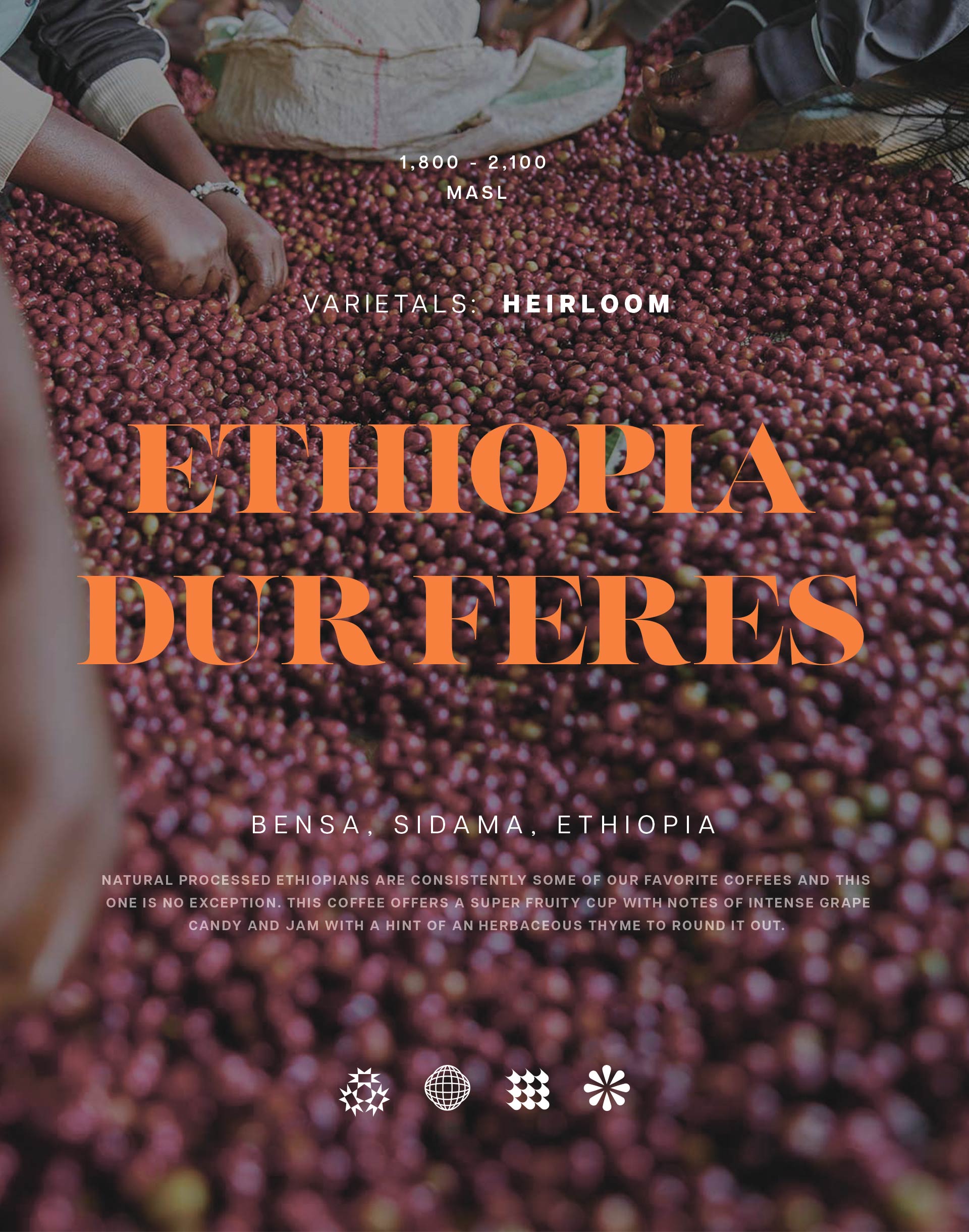

Ethiopia - Dur Feres - Natural Heirloom
Natural processed Ethiopians are consistently some of our favorite coffees and this one is no exception. This coffee offers a super fruity cup with notes of intense grape candy and jam with a hint of an herbaceous thyme to round it out.
Region: Bensa, Sidama, Ethiopia
Varieties: Heirloom
Process: Natural
Elevation: 1,800 - 2,100 masl
All orders will be roasted on the Monday after ordering and shipped Tuesday.
10oz of Whole Bean Coffee
Pairs well with

Ethiopia - Dur Feres - Natural Heirloom
If you have any questions, you are always welcome to contact us. We'll get back to you as soon as possible, within 24 hours on weekdays.
Shipping Information
Use this text to answer questions in as much detail as possible for your customers.
Customer Support
Use this text to answer questions in as much detail as possible for your customers.
FAQ’s
Use this text to answer questions in as much detail as possible for your customers.
Contact Us
Use this text to answer questions in as much detail as possible for your customers.
Varieties: Heirloom
Producer: Various
Origin: Bensa, Sidama, Ethiopia
Process: Natural
Elevation: 1,800 - 2,100 masl
Talk Coffee With Me
Heirloom Varieties
Heirloom coffee varieties refer to the ancient, indigenous coffee plants that have been grown in Ethiopia—the birthplace of coffee—for centuries. These varieties are cherished for their genetic diversity and complexity, which contribute to the extraordinary range of flavors found in Ethiopian coffees. Unlike more standardized coffee varieties cultivated around the world, each heirloom variety in Ethiopia can bring a unique profile to the cup, influenced by the specific microclimate and soil conditions of its region.
At Verb Coffee, we are passionate about sourcing heirloom varieties because they represent the heart and history of coffee itself. These varieties yield cups that are as rich in story as they are in flavor. Our naturally processed heirloom coffees from Bensa, Sidama, are a testament to this tradition, offering a coffee experience that is deeply layered with notes of grape candy, jam, and a subtle hint of thyme, providing a taste that is not only delicious but also a direct link to the ancient heritage of coffee.
Natural Process
Natural processing, also known as dry processing, is one of the oldest methods of coffee processing. In this method, whole coffee cherries are dried in the sun, often on raised beds or patios, with the fruit still surrounding the coffee bean. This technique is favored in regions with ample sunlight and minimal rainfall, such as Ethiopia, where it originated.
At Verb Coffee, we value natural processing for its ability to imbue the coffee beans with rich, bold, and intricate flavors. As the cherries dry, they ferment slightly, which transfers the sugars and fruity flavors of the cherry to the beans, resulting in a coffee that is intensely fruity and complex. This process can produce stunning flavor notes, such as the grape candy and jam-like qualities found in our Ethiopian offerings.
By choosing naturally processed coffees, we bring to our customers a taste that is not only vibrant and layered but also a true reflection of the bean's natural sweetness and character. This method, while labor-intensive, showcases our commitment to offering coffees that provide an extraordinary sensory experience.
Natural is when the entire fruit is left on the seeds during drying. Once entirely dried the husk and parchment layer are removed in a dry mill. Due to the longer contact time with the cherry this process when done correctly creates a fruity and sweet cup.
Honey is between a washed and natural process. Part of the husk is removed and then dried with the remaining mucilage, which looks like the color of honey hence the name. There are various types of honey from white, red, or black depending on how much of the mucilage is removed. The taste profile ranges from more clean and mellow to more sweet and fruity.
Anaerobic is the newest and most complicated processing technique. It is an umbrella term for many different types of fermentations that break down the outer fruit. Typically, this refers to the intentional limitation of oxygen during fermentation and extended time in the fermentation phase. There are many different kinds of processing that can fall under this category such as carbonic maceration, thermic shock, and yeast inoculation. These are typically the most wild and flavor intense tasting coffees.
Why Does Your Coffee Always Rotate?
One of the things that excites us the most about coffee is the wide range of flavors that can exist within it. We love searching for new and unique offerings, which usually means they come in small quantities.
General Brewing Guide
These recipes are a good starting point to brew your coffee. Adjust by taste to suit your equipment and preferences.
Pour-Over
- Coffee: 18g
- Water: 320g
Brew Steps:
- Bloom (0:00): Pour 100g water to saturate all grounds.
- First Pour (0:35): Add water to 220g in slow concentric circles.
- Second Pour (1:45): Finish pouring to 320g total.
- Complete (4:00): Allow all water to drip through.
Espresso
- Coffee: 19g
- Total Output: 48g espresso
- Time: Adjust grind size until time is around 25 seconds to get the desired total output.

